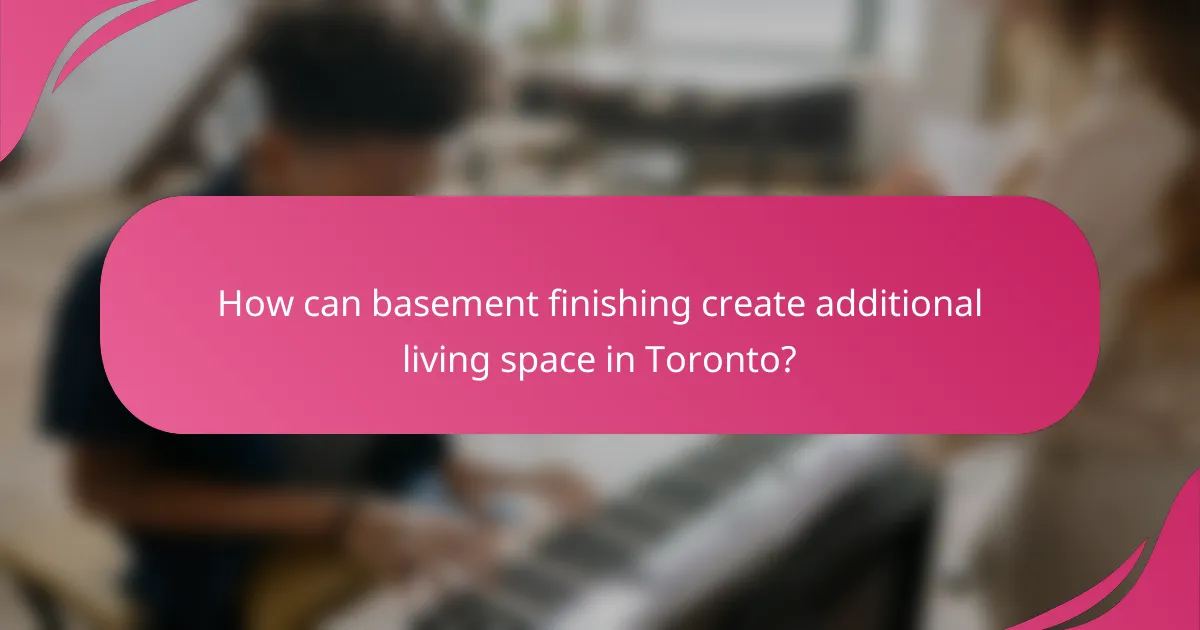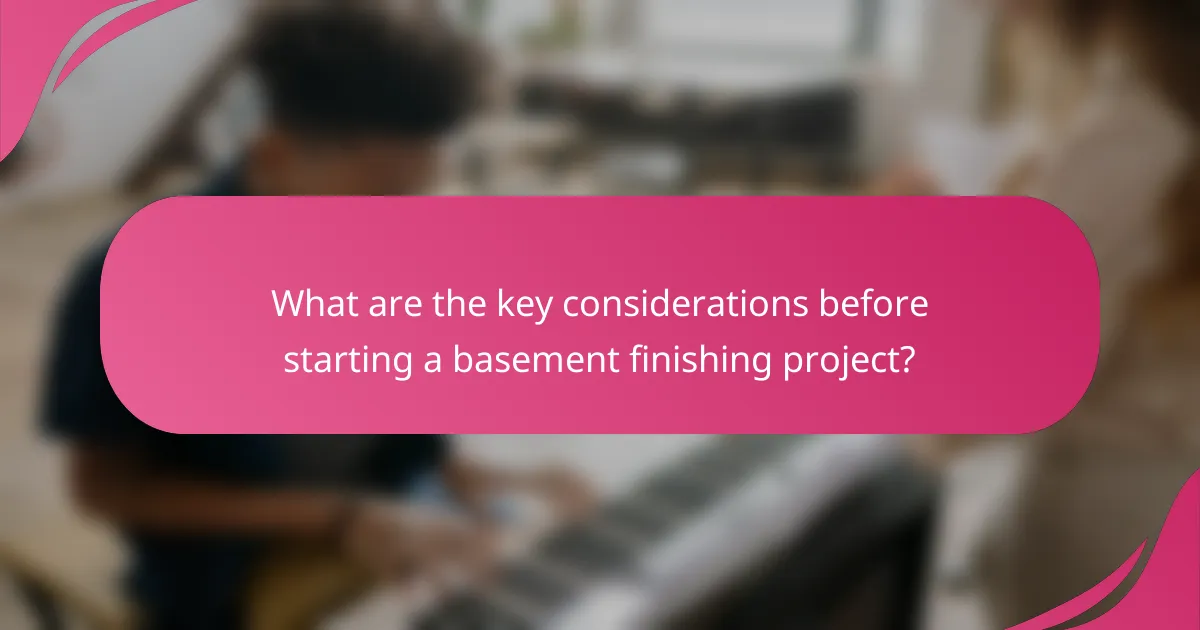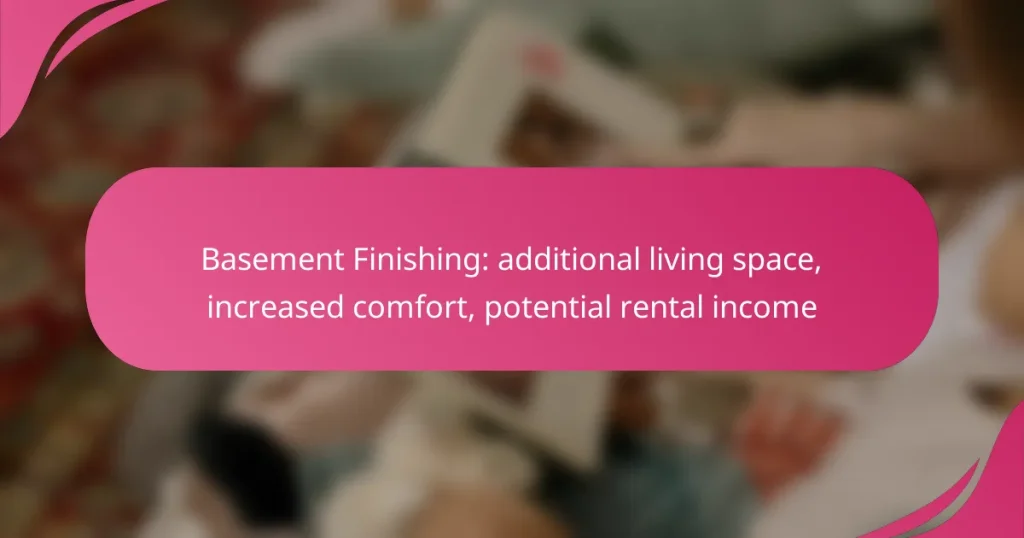Finishing a basement can transform an underutilized area into valuable additional living space, enhancing both comfort and functionality. This upgrade not only improves insulation and climate control but also opens the door to potential rental income, making it an attractive option for homeowners looking to maximize their property’s value.

How can basement finishing create additional living space in Toronto?
Finishing a basement in Toronto can significantly increase your home’s usable living space, providing a versatile area for various activities. This transformation not only enhances comfort but can also add value to your property and potentially generate rental income.
Increased square footage
By finishing your basement, you effectively add square footage to your home without the need for an expensive extension. This additional space can be used for a variety of purposes, such as a family room, home office, or guest suite. In Toronto, where real estate is at a premium, this extra space can make a substantial difference in your home’s marketability.
Consider that a finished basement can add anywhere from 50% to 70% of its square footage to your home’s total value, depending on the quality of the finish and the overall market conditions. This makes it a worthwhile investment for homeowners looking to maximize their property’s potential.
Flexible design options
Finishing a basement allows for a wide range of design possibilities tailored to your needs. Whether you envision a cozy entertainment area, a playroom for children, or a rental suite, the design can be customized to fit your lifestyle. You can choose from various styles, colors, and layouts that complement the rest of your home.
In Toronto, it’s essential to consider local building codes and regulations when designing your basement. Ensure that your plans meet the requirements for egress windows, ceiling height, and ventilation to create a safe and comfortable environment.
Enhanced functionality
A finished basement can significantly enhance the functionality of your home. It provides a dedicated space for activities that may be disruptive in other areas, such as a home gym or a media room. This separation can lead to a more organized and peaceful living environment.
Additionally, if you choose to create a rental suite, it can serve as a source of income. In Toronto, where rental demand is high, a well-finished basement apartment can yield monthly rents that contribute significantly to your mortgage or living expenses. Be sure to research the rental market in your area to set competitive rates and attract tenants.

What are the benefits of a finished basement for comfort?
A finished basement enhances comfort by providing additional living space that is more enjoyable and functional. This transformation can lead to improved insulation, better climate control, and reduced noise, making the basement a desirable area for relaxation or entertainment.
Improved insulation
Finishing a basement typically involves adding insulation to walls and ceilings, which helps maintain a consistent temperature throughout the year. Proper insulation can reduce heating and cooling costs by preventing drafts and heat loss, leading to energy savings of around 10-20% on utility bills.
When selecting insulation materials, consider options like fiberglass batts or spray foam, which can effectively minimize heat transfer. Ensure that the insulation meets local building codes for optimal performance and safety.
Better climate control
A finished basement allows for better climate control through the installation of heating and cooling systems tailored to the space. This can include extending existing HVAC systems or adding separate units, ensuring comfortable temperatures year-round.
Incorporating dehumidifiers can also help manage moisture levels, preventing mold growth and enhancing air quality. Regular maintenance of these systems is crucial to ensure they operate efficiently and effectively.
Noise reduction
Finishing a basement can significantly reduce noise from both inside and outside the home. Adding soundproofing materials, such as acoustic panels or carpets, can help absorb sound and create a quieter environment, ideal for activities like watching movies or working from home.
Consider using resilient channels and soundproof drywall during the finishing process to further enhance noise reduction. This investment can lead to a more peaceful living space, making the basement a preferred area for relaxation or productivity.

How does a finished basement generate potential rental income?
A finished basement can generate potential rental income by providing a separate living space that can be rented out to tenants. This additional living area not only increases the overall usable space in a home but can also attract renters looking for affordable housing options.
Separate entrance possibilities
Creating a separate entrance for a finished basement can significantly enhance its rental appeal. This allows tenants to have their own access, promoting privacy and independence. Homeowners should consider local building codes and regulations when designing this feature to ensure compliance.
Options for separate entrances include adding a door leading directly outside or utilizing existing basement windows to create an egress point. These modifications can increase the functionality of the space and make it more attractive to potential renters.
Increased property value
Finishing a basement can lead to an increase in property value, making it a worthwhile investment for homeowners. A well-designed basement can add significant square footage, which is often reflected in the home’s market price. In many cases, this increase can be in the range of tens of thousands of dollars.
When evaluating the potential return on investment, homeowners should consider the quality of the finishes and the overall design. High-quality materials and thoughtful layouts can yield better returns when it comes time to sell or rent the property.
Attracting tenants in urban areas
In urban areas where housing demand is high, a finished basement can be an attractive option for potential tenants. Many renters seek affordable living spaces, and a basement unit can provide a cost-effective solution compared to traditional apartments. This is particularly relevant in cities where rental prices are rising.
To effectively attract tenants, homeowners should market the unique features of the finished basement, such as its size, amenities, and proximity to public transportation. Highlighting these aspects can help differentiate the rental from other available options in the area.

What are the costs associated with basement finishing in Canada?
The costs of basement finishing in Canada can vary widely based on factors such as size, materials, and design choices. Homeowners should expect to spend anywhere from CAD 20,000 to CAD 60,000 for a complete renovation, depending on the complexity and quality of the work.
Average renovation costs
The average cost for finishing a basement typically ranges from CAD 30 to CAD 100 per square foot. This includes expenses for insulation, drywall, flooring, and electrical work. For a standard 1,000 square foot basement, total costs can range from CAD 30,000 to CAD 100,000.
Additional features like bathrooms or kitchens can significantly increase costs. For instance, adding a bathroom can add CAD 10,000 to CAD 20,000 to the overall budget.
Cost-saving tips
To save on basement finishing costs, consider doing some of the work yourself, such as painting or installing flooring. This can reduce labor expenses significantly. Additionally, sourcing materials from local suppliers or sales can lead to substantial savings.
Another effective strategy is to prioritize essential renovations first, such as insulation and flooring, and postpone non-essential upgrades like custom cabinetry or high-end finishes.
Financing options
Homeowners can explore various financing options for basement finishing, including home equity loans, personal loans, or renovation-specific loans. Home equity loans often offer lower interest rates since they are secured against the home’s value.
Additionally, some financial institutions provide special programs for home renovations that may include lower rates or flexible repayment terms. It’s advisable to compare different lenders to find the best option that suits your financial situation.

What are the key considerations before starting a basement finishing project?
Before starting a basement finishing project, it’s essential to evaluate several key factors that can impact the outcome. These include understanding local building codes, addressing moisture issues, and planning the design and layout effectively.
Building codes and permits
Building codes and permits are crucial for ensuring that your basement finishing project complies with local regulations. Check with your local municipality to determine what permits are required, as failure to obtain them can lead to fines or complications when selling the property.
Common permits may include electrical, plumbing, and structural modifications. It’s advisable to consult a professional or contractor familiar with local codes to navigate this process smoothly.
Moisture and waterproofing
Moisture control is vital in basement finishing to prevent mold and structural damage. Assess the current moisture levels in your basement and consider installing a waterproofing system if necessary. This may involve sealing cracks, applying waterproof paint, or installing a sump pump.
Regularly monitor humidity levels and ensure proper ventilation to maintain a dry environment. Investing in moisture barriers can save you from costly repairs down the line.
Design and layout planning
Effective design and layout planning can maximize the utility of your finished basement. Consider how you intend to use the space—whether for a family room, home office, or rental unit—and plan accordingly. This includes determining the placement of walls, windows, and entrances.
Utilize software tools or consult with a designer to visualize the space. Keep in mind that open layouts can create a more spacious feel, while defined areas can enhance functionality. Prioritize natural light and accessibility in your design choices.

What are the latest trends in basement finishing?
Recent trends in basement finishing focus on maximizing functionality and comfort while enhancing aesthetic appeal. Homeowners are increasingly looking to create versatile spaces that can serve multiple purposes, such as family rooms, home offices, or rental units.
Multi-functional spaces
Designing multi-functional spaces is a key trend in basement finishing. Homeowners are opting for layouts that allow for various activities, such as a combination of entertainment areas and workspaces. This flexibility can accommodate family needs and adapt to changing lifestyles.
Consider incorporating features like foldable furniture, modular seating, and built-in storage to optimize space usage. For example, a basement can include a guest bedroom that doubles as a home gym or an office area that transforms into a playroom.
Energy efficiency
Energy efficiency is becoming a priority in basement renovations. Homeowners are investing in insulation, energy-efficient windows, and LED lighting to reduce energy costs and improve comfort. Proper insulation not only keeps the space warm in winter but also cool in summer.
When finishing a basement, consider using materials that meet energy efficiency standards. For instance, insulated wall panels can significantly reduce heating and cooling expenses, making the space more sustainable and cost-effective in the long run.
Smart home integration
Smart home technology is increasingly being integrated into basement finishing projects. Homeowners are looking to enhance convenience and security by installing smart lighting, thermostats, and security systems. These features can be controlled remotely, adding an extra layer of comfort and efficiency.
For example, smart lighting can be programmed to adjust based on occupancy, while smart thermostats can help maintain optimal temperatures. This integration not only improves the living experience but can also increase the property’s value.
Stylish design elements
Stylish design elements are essential in modern basement finishing. Homeowners are choosing high-quality finishes, such as hardwood flooring, elegant cabinetry, and contemporary fixtures, to create inviting and attractive spaces. A well-designed basement can seamlessly blend with the rest of the home.
Incorporating design trends like open layouts, neutral color palettes, and accent walls can enhance the visual appeal. Additionally, using high-end materials can elevate the space, making it feel less like a basement and more like a desirable living area.


